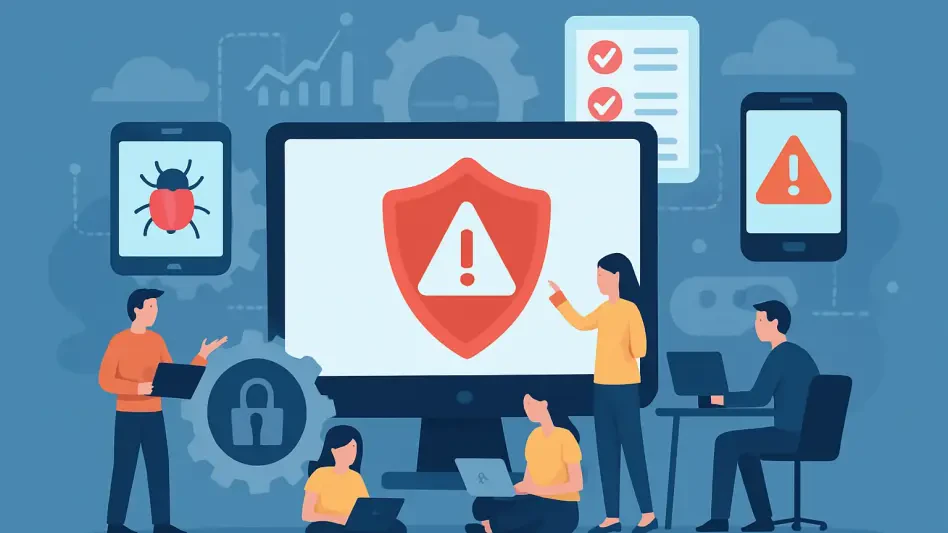In an era where digital threats loom larger than ever, businesses face an unrelenting challenge to protect their IT systems from increasingly sophisticated cyberattacks that can compromise sensitive data and disrupt operations. Vulnerability management software has become an indispensable ally in this fight, empowering organizations to detect, assess, and remediate security weaknesses before they can be exploited by malicious actors. These tools are not mere luxuries but critical components of a robust cybersecurity strategy, especially as breaches continue to cost millions in damages and erode trust. The latest rankings for 2025 shed light on the most effective solutions available, offering a roadmap for companies seeking to fortify their defenses. From automating tedious vulnerability scans to prioritizing the most pressing risks, these platforms cater to a wide spectrum of needs, whether for small startups or vast enterprises. This article delves into the standout performers among ten leading tools, including industry stalwarts like Tenable Nessus and Qualys VMDR, as well as innovative contenders such as Wiz and Jit. Each has been meticulously evaluated based on functionality, user experience, scalability, and alignment with diverse business environments. By exploring key features, emerging trends, and detailed insights into top solutions, the discussion aims to guide decision-makers in selecting the right tool to safeguard their digital assets against the ever-evolving landscape of cyber risks.
The Critical Role of Vulnerability Management Today
In the current digital climate, cybersecurity stands as a paramount concern for organizations across all sectors, with the potential for data breaches to inflict severe financial and reputational harm. Vulnerability management software serves as a frontline defense, systematically scanning networks to identify weaknesses, assessing their severity, and providing actionable steps for remediation. This proactive approach is vital in a time when cyber threats target everything from traditional on-premises servers to modern cloud infrastructures. Beyond merely reacting to incidents, these tools enable businesses to anticipate and neutralize risks before they escalate into full-blown crises. The importance of such systems cannot be overstated, as they help maintain operational continuity and protect sensitive information from falling into the wrong hands. With attackers constantly refining their methods, staying ahead requires software that not only detects flaws but also adapts to new challenges in real time, ensuring that vulnerabilities are addressed swiftly and efficiently.
Moreover, the push for regulatory compliance adds another layer of urgency to adopting robust vulnerability management solutions. Standards such as GDPR, HIPAA, and PCI-DSS impose strict requirements on data security, and failure to comply can result in hefty fines and legal repercussions. Many of the leading tools in 2025 are equipped with features to support compliance efforts, offering built-in auditing capabilities and detailed reporting to demonstrate adherence to these mandates. For industries handling sensitive customer information, such as healthcare or finance, this functionality is a lifeline, ensuring that security measures align with legal obligations. As cyber risks grow more complex, the role of vulnerability management software extends beyond technical protection to encompass a broader responsibility of safeguarding trust and meeting stakeholder expectations, making it an essential investment for any forward-thinking organization.
Defining Features of Leading Software Solutions
A hallmark of the top vulnerability management tools in 2025 is their emphasis on automation, a feature that significantly reduces the burden of manual processes in identifying and addressing security gaps. For organizations managing expansive IT environments, manually tracking thousands of potential vulnerabilities is not only impractical but also prone to errors. Platforms like Qualys VMDR and Rapid7 InsightVM excel in this area by automating the entire lifecycle of vulnerability management, from scanning to remediation. This capability allows security teams to focus on strategic priorities rather than getting bogged down in repetitive tasks. Automation also ensures faster response times, which is critical when dealing with time-sensitive threats that could be exploited within hours of discovery. By streamlining workflows, these tools enhance efficiency and minimize the risk of oversight, proving indispensable for enterprises with limited resources or high-stakes environments.
Another defining characteristic is the ability to provide real-time monitoring and continuous scanning, ensuring that emerging threats are caught as soon as they surface. In a landscape where cyberattacks can evolve overnight, relying on periodic scans is no longer sufficient to maintain a secure posture. Solutions such as Tenable Nessus and Balbix stand out for their continuous visibility into vulnerabilities, a feature particularly valuable for dynamic setups involving cloud or hybrid systems. This persistent oversight helps organizations detect new risks in real time, whether they stem from software updates, configuration changes, or newly discovered exploits. Such immediacy is a game-changer, enabling rapid action to close security gaps before they can be leveraged by attackers, and it underscores why real-time capabilities are a non-negotiable trait among the best tools available today.
Integration and scalability further distinguish the leading platforms, as businesses require solutions that mesh seamlessly with their existing security ecosystems and grow alongside their operations. Tools like Rapid7 InsightVM and Cisco Vulnerability Management offer robust integration with systems such as SIEM, SOAR, and ITSM platforms, creating a cohesive defense strategy that leverages data from multiple sources. Scalability, meanwhile, ensures that a tool remains effective whether deployed by a small team or a global corporation. Wiz, for instance, is tailored for multi-cloud environments, while Intruder provides a lightweight option for smaller entities with growth potential. These qualities ensure that vulnerability management software not only fits current needs but also adapts to future expansions, making them vital considerations for long-term planning and investment in cybersecurity infrastructure.
Trends Driving the Industry Forward
One of the most prominent trends shaping vulnerability management in 2025 is the accelerating shift toward cloud and hybrid environments, reflecting the broader adoption of cloud computing across industries. As organizations migrate to cloud platforms or maintain a mix of on-premises and cloud systems, the security challenges become more intricate, with risks like misconfigurations and container vulnerabilities coming to the forefront. Tools such as Wiz and Qualys VMDR are at the cutting edge of this trend, offering specialized capabilities to address the unique threats inherent in these setups. Their focus on cloud-native security ensures comprehensive protection across diverse infrastructures, from AWS to Azure, highlighting how the industry is evolving to meet modern demands. This trend underscores a critical need for solutions that can navigate the complexities of distributed environments without sacrificing depth or accuracy in vulnerability detection.
Another transformative force is the integration of artificial intelligence and machine learning into vulnerability management platforms, enhancing their ability to manage vast amounts of data and reduce alert fatigue. With thousands of vulnerabilities potentially flagged in a single scan, security teams often struggle to discern which issues pose the greatest threat. Platforms like Balbix and Qualys VMDR leverage AI to prioritize risks based on exploit likelihood and potential impact, filtering out noise and focusing attention on critical concerns. This intelligent approach not only boosts efficiency but also empowers organizations to allocate resources strategically, addressing the most dangerous vulnerabilities first. As cyber threats grow in volume and sophistication, the reliance on such advanced technologies signals a shift toward data-driven decision-making, setting a new standard for what constitutes an effective security tool.
Deep Dive into Standout Performers
Tenable Nessus continues to hold a strong position among vulnerability management solutions due to its proven reliability and comprehensive coverage of over 59,000 Common Vulnerabilities and Exposures (CVEs). Its flexibility in supporting both agent-based and agentless scanning makes it adaptable to a variety of environments, from cloud to on-premises setups. Additionally, its robust compliance templates cater to industries with stringent regulatory requirements, ensuring that businesses can meet standards without added complexity. While continuous scanning may occasionally strain system resources, and advanced configurations demand skilled personnel, Tenable Nessus remains a cost-effective choice for a wide range of organizations. Its balance of affordability and functionality positions it as a benchmark for small to medium-sized businesses and large enterprises alike, seeking a dependable tool to bolster their security posture.
Qualys VMDR targets larger enterprises with an automation-centric design that streamlines the entire vulnerability management process, from detection to response. Its AI-driven risk prioritization, covering over 70,000 vulnerability checks, ensures that critical threats are addressed promptly, while its cloud-native architecture eliminates the need for extensive infrastructure setup. However, its higher cost and inherent complexity may pose barriers for smaller organizations lacking dedicated cybersecurity teams. Despite this, Qualys VMDR excels in environments with heavy compliance demands, offering centralized remediation features that enhance operational efficiency. For corporations managing complex, multi-faceted IT landscapes, this platform stands as a powerful ally, delivering scalability and precision in tackling the most pressing security challenges.
Rapid7 InsightVM distinguishes itself with real-time scanning and dynamic threat feeds, providing up-to-the-minute visibility into vulnerabilities across hybrid environments. Its strong integration capabilities with tools like ServiceNow and Jira facilitate seamless remediation workflows, making it a favorite for enterprises prioritizing efficiency. However, the platform’s learning curve and investment requirements may challenge mid-sized companies or those with limited technical expertise. Nevertheless, its focus on detailed analytics for risk prioritization ensures that security teams can focus on the most impactful threats. Rapid7 InsightVM is particularly suited for organizations that require a modern, connected approach to vulnerability management, ensuring that their defenses remain agile in the face of evolving cyber risks.
Niche Solutions and Specialized Strengths
Microsoft Defender Vulnerability Management offers unique value for organizations deeply embedded in the Microsoft ecosystem, with native integration into Azure and Microsoft 365 environments. By leveraging telemetry data for endpoint risk analysis and providing exposure scoring, it simplifies prioritization for users already reliant on Microsoft infrastructure. However, its narrower focus limits versatility for businesses with diverse or non-Microsoft-centric systems, reducing its appeal in mixed environments. Despite this constraint, it delivers a seamless experience for compatible setups, minimizing deployment friction and enhancing security within familiar workflows. This tool is an ideal match for enterprises committed to Microsoft technologies, ensuring that vulnerability management aligns closely with their existing operational framework.
Wiz emerges as a leader for cloud-first organizations, providing agentless scanning and deep visibility into multi-cloud architectures like AWS, Azure, and GCP. Its contextual risk analysis, which includes attack-path mapping, offers nuanced insights into potential vulnerabilities, making it a top choice for businesses prioritizing cloud security. However, its premium pricing and limited focus on traditional on-premises systems may deter organizations with hybrid or legacy setups. Nevertheless, Wiz addresses the growing complexities of cloud-native risks with precision, catering to enterprises that have fully embraced digital transformation. For companies navigating the intricacies of multi-cloud environments, this platform provides a tailored solution that keeps pace with modern infrastructure demands.
Intruder fills a critical niche for smaller businesses or those new to vulnerability management, offering a cloud-based, user-friendly platform with minimal setup requirements. Its automated scanning and straightforward risk prioritization enable quick action without the need for extensive technical know-how, making it accessible to teams with limited resources. While its simplicity restricts customization and scalability for larger, more complex enterprises, it serves as an excellent entry point for startups or growth-focused firms. Intruder’s design prioritizes ease of use, ensuring that even organizations without dedicated security staff can implement effective vulnerability management practices. This focus on accessibility highlights its role as a practical option for businesses taking their first steps toward robust cybersecurity.
Future-Proofing Cybersecurity Strategies
Jit introduces a developer-centric perspective by embedding vulnerability management into DevSecOps pipelines, automating scans during the development lifecycle through CI/CD integration. This “security-as-code” approach ensures that vulnerabilities are addressed early in the process, a significant advantage for agile teams and startups focused on rapid iteration. However, its emphasis on code-related risks limits its applicability to broader IT infrastructure concerns, narrowing its audience to development-heavy environments. Despite this specialization, Jit’s lightweight design and focus on early intervention make it a valuable tool for organizations prioritizing security within software creation. Its innovative stance reflects a growing recognition of the need to integrate security practices into every stage of technology development, ensuring safer end products.
WithSecure Elements Exposure Management strikes a balance between usability and enterprise-grade features, offering continuous scanning and actionable remediation guidance for mid-sized to large organizations. Its integration with endpoint protection enhances overall coverage, while compliance reporting supports regulatory adherence. Although it may lack the advanced predictive analytics found in competitors like Balbix or Cisco, its straightforward interface appeals to businesses seeking simplicity without sacrificing depth. This platform caters to entities that require a versatile, user-friendly solution capable of handling significant security demands. By bridging the gap between accessibility and robust functionality, WithSecure Elements ensures that companies can maintain a strong defense without overwhelming their teams, positioning it as a practical choice for sustained cybersecurity efforts.
Reflecting on Key Insights for Decision-Making
Looking back, the evaluation of vulnerability management software in 2025 revealed a landscape rich with diverse solutions, each addressing specific organizational challenges with unique strengths. Tools like Tenable Nessus demonstrated enduring reliability and affordability, while Qualys VMDR showcased the power of automation for complex enterprises. Innovations from Wiz highlighted the importance of cloud-native security, and Jit’s developer-focused approach underscored the value of early-stage vulnerability mitigation. Common threads such as real-time monitoring, AI-driven prioritization, and compliance support emerged as critical benchmarks across the board, reflecting the industry’s push toward proactive, intelligent defenses. Each platform, from Rapid7 InsightVM’s integration prowess to Intruder’s simplicity, played a pivotal role in shaping a comprehensive view of what modern cybersecurity demands.
Moving forward, businesses are advised to align their choice of vulnerability management software with specific needs, considering factors like infrastructure complexity, budget constraints, and team expertise. For small to medium-sized entities, cost-effective and user-friendly options prove most practical, while large corporations benefit from scalable, feature-rich systems. Cloud-first organizations find tailored solutions to address unique risks, and development teams gain from tools integrated into their workflows. The next steps involve thorough assessments of current security gaps, alongside trials of shortlisted platforms to ensure compatibility. By focusing on long-term scalability and seamless integration with existing systems, companies can build resilient strategies to stay ahead of evolving threats, securing their digital assets for years to come.








